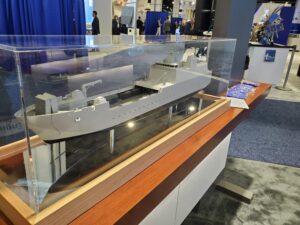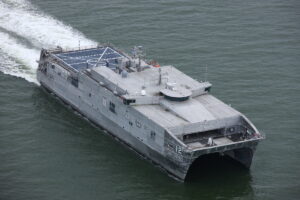The Marine Corps is exploring several ways to move groups of Marines around the Indo-Pacific region while waiting for the Light Amphibious Warship (LAW), which been pushed back several years.
The service’s annual Force Design 2030 update, released on May 9, said that given mobility requirements, the Marine Corps must invest in littoral maneuver capabilities in a Medium Landing Ship (LSM) beyond the traditional larger L-class amphibious ships, notably through the LAW.
“While we await the delivery of LSM, which post-dates the planned operational readiness of our MLRs, we will explore a family of systems bridging plan—including, Expeditionary Transfer Dock (ESB), Expeditionary Fast Transport (T-EPF), Landing Craft Utility (LCU), and leased hulls—that can provide a basic level of mobility. Although not optimal, such vessels will provide both operational capability and a sound basis for live experimentation and refining detailed requirements for the LAW program,” the document reads.
The Navy’s FY 2023 budget request revealed the Navy was pushing back procurement of the first of up to 35 LAWs to FY ‘25, three years later than first planned. Budget documents show the Navy plans to procure the second vessel in FY ‘26 and then two in FY ‘27 (Defense Daily, March 30).
In contrast, last December, Marine Commandant Gen. David Berger said he expected LAW to be one of two new capabilities coming online for the service starting in 2023 and they would take LAW “as fast as we can procure them” (Defense Daily, Dec. 14, 2021).

In early 2021, Marine Maj. Gen. Tracy King, director of Expeditionary Warfare (OPNAV N95), said the Navy previously planned to start research, development, test and evaluation within one year and buy the first LAW by late FY ‘22 (Defense Daily, Jan. 14, 2021).
During a panel Tuesday at the annual Modern Day Marine conference, Deputy Commandant for Combat Development and Integration Lt. Gen. Karsten Heckl said the Marine Corps has already contracted with a commercial vessel to start experimenting with LAW concepts.
“We have contracted a commercial variant stern landing vessel [SLV], that will be looking like summer or fall and we’ll immediately deploy it to Hawaii where we have stood up the 3rd Marine Littoral Regiment to begin aggressive experimentation, all with my team plugged in,” he said.
Heckl said since the LAW is now a few more years out from being produced, “so we’re taking an opportunity to do some experimentation and refinement prototyping so that we get what we need – what the Marines need.”
Heckl told reporters during a media roundtable following the panel event that the Marine Corps contract for the SLV has options to lease two more vessels to help develop LAW concepts.
“Quite frankly, the fact that the LAW got pushed back, as you know, we have five companies doing prototyping now, to figure out what’s it’s going to be. This is simply going to inform and make it a better product,” he continued.
The Marine Corps confirmed to Defense Daily the SLV was contracted with Hornbeck Offshore Services for the LAW surrogate last November.
Heckl said the Marine Corps is in talks with other builders of vessels like the SLV, including the Australia-based Sea Transport Solutions.

He noted there is risk in any gap of military capabilities, but he argued the SLV, ESBs and T-EPFs offer “a lot of options out there…there’s a lot of things we can do.”
Heckl said in a recent trip to the Gulf Coast he visited several shipbuilders and walked on a T-EPF, noting its useful functions for MLR purposes.
“It’s a ship that can do 35 knots, carry a few hundred Marines and their gear with a flight deck. I mean, so there’s a lot of options there.”
During the panel, Heckl underscored LAW will be a shore-to-shore connector, not requiring a pier or other ships, “which is vital, particularly, in a maritime dominant operating environment such as the Indo-Pacific.”
He argued in a potential U.S. Indo-Pacific region conflict with China he thinks port facilities and larger runways and airports will be targeted first.
During the media roundtable, Heckl said the Expeditionary Advanced Base Operations (EABO) concept calls for advanced naval bases, with Guam an example of a larger intermediate staging base. The advanced naval base would use the Marine Corps’ organic lift capabilities of KC-130Js and LAWs to move forces around.
He noted the KC-130J does not require an airfield, with recent tests using an old 4,000 feet World War II-era airfield in Palau.
“There’s no pier…you could easily envision that we would have an advanced naval base there with the gears and supplies that we would use for sustainment, and only a shore-to-shore connector is going to be able to accomplish that.”
Heckl confirmed an advanced naval base in Palau would be close enough for the LAW to traverse. Palau is about 700 nautical miles from Guam and 1,200 nautical miles from Taiwan, well within the ship’s target range of 3,500 nautical miles.
The LAW is planned to be 200 to 400 feet long, able to transport upward of 75 Marines and their gear up to at least 3,500 nautical miles, carry up to 8,000 to 10,000 square feet of cargo to primarily support the Marine Littoral Regiment (MLR), and a crew of up to 40 Navy sailors.